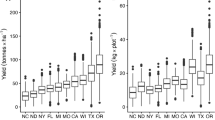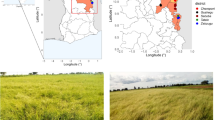Abstract
Currently, Norway spruce (Picea abies) breeding in Sweden is based on crosses between the best clones followed by clonal testing of the progenies to select for the long-term breeding population. An alternative breeding strategy called “Breeding without Breeding” (BwB) is proposed, which, in principle, relies on the DNA marker-based pedigree reconstruction from wind-pollinated progenies instead of controlled crosses. To test whether the pedigree structure could be established from progenies of clonal trials, we investigated the spatial pattern of local pollen flow and paternity assignment in a clone archive of Norway spruce. The results showed that 42% of the progeny can be assigned to fathers within 30-m distance with high confidence. Effective pollen dispersal decreased rapidly with distance and followed exponential distribution on local scale. The extent of close-neighbor (within 6 m) mating ranged from 0% to 48% among grafts with an average of 13%. Distance explained 25% deviance in mating success, and other factors such as phenology and spatial configuration of the clones should have contributed the rest. The success of parentage assignment in clone archive opens up the possibility to apply BwB in clonal trials of species that are easy to propagate vegetatively. This procedure could substantially shorten the breeding cycle and still give similar gain per year as the conventional breeding.





Similar content being viewed by others
References
Besnard G, Achere V, Rampant PF, Favre JM, Jeandroz S (2003) A set of cross-species amplifying microsatellite markers developed from DNA sequence databanks in Picea (Pinaceae). Mol Ecol Notes 3:380–383
Brenner CH (1997) Symbolic kinship program. Genetics 145:535–542
Burczyk JL, Prat D (1997) Male reproductive success in Pseudotsuga menziesii (Mirb.) Franco: the effects of spatial structure and flowering characteristics. Heredity 79:638–647
Burczyk J, Adams WT, Shimizu JY (1996) Mating patterns and pollen dispersal in a natural Knobcone pine (Pinus attenuata Lemmon) stand. Heredity 77:251–260
Burczyk J, Lewandowski A, Chałupka W (2004) Local pollen dispersal and distant gene flow in Norway spruce (Picea abies [L.] Karst.). For Ecol Manage 197:39–48
Danusevicius D, Lindgren D (2002) Efficiency of selection based on phenotype, clone and progeny testing in long-term breeding. Silvae Genet 51:19–26
El-Kassaby YA, Lstiburek M (2009) Breeding without breeding. Genet Res 91:111–120
El-Kassaby YA, Lstibůrek M, Liewlaksaneeyanawin C, Slavov GT, Howe GT (2007) Breeding without breeding: approach, example, and proof of concept. In: Isik F (ed) Proceedings of the IUFRO division 2 joint conference: low input breeding and conservation of forest genetic resources. Antalya, Turkey, pp 43–54
Erickson VJ, Adams WT (1989) Mating success in a coastal Douglas-fir seed orchards as affected by distance and floral phenology. Can J For Res 19:1248–1255
Evett IW, Weir BS (1998) Interpreting DNA evidence: statistical genetics for forensic scientists. Sinauer Associates, Sunderland
Goto S, Miyahara F, Ide Y (2002) Monitoring male reproductive success in a Japanese black pine clonal seed orchard with RAPD markers. Can J For Res 32:983–988
Goudet J (1995) FSTAT (Version 1.2): a computer program to calculate F-statistics. J Hered 86:485–486
Hardy OJ, Vekemans X (2002) SPAGEDi: a versatile computer program to analyse spatial genetic structure at the individual or population levels. Mol Ecol Notes 2:618–620
Hardy OJ, Gonzalez-Martinez SC, Colas B, Freville H, Mignot A, Olivieri I (2004) Fine-scale genetic structure and gene dispersal in Centaurea corymbosa (Asteraceae). II. Correlated paternity within and among sibships. Genetics 168:1601–1614
Hodgetts RB, Aleksiuk MA, Brown A, Clarke C, Macdonald E, Nadeem S et al (2001) Development of microsatellite markers for white spruce (Picea glauca) and related species. Theor Appl Genet 102:1252–1258
Hoffmann JP (2003) Generalized linear models: an applied approach. Allyn & Bacon, Boston
Kalinowski ST, Taper ML, Marshall TC (2007) Revising how the computer program CERVUS accommodates genotyping error increases success in paternity assignment. Mol Ecol 16:1099–1106
Kang KS, Bila AD, Harju AM, Lindgren D (2003) Estimation of fertility variation in forest tree populations. Forestry 76:330–344
Karlsson B, Rosvall O (1993) Breeding programs in Sweden—Norway spruce: proceedings of the Nordic group for tree breeding: progeny testing and breeding strategies. Edinburgh, Scotland, pp 128–134
Kimoto S (1967) Some quantitative analysis on the chrysomelid fauna of Ryukyu Archipelago. Esakia 6:27–54
Kjaer ED (1996) Estimation of effective population number in a Picea abies (Karst) seed orchard based on flower assessment. Scand J Forest Res 11:111–121
Lindgren D (2009) Picea abies breeding in Sweden is based on clone testing. Dendrobiology 61 Supplement: 79–82
Lindgren D, Nilsson J-E (1985) Calculations concerning selection intensity. Dept. of Forest Genetics and Plant Physiology. The Swedish University of Agricultural Science, Umeå
Loiselle BA, Sork VL, Nason J, Graham C (1995) Spatial genetic structure of a tropical understory shrub, Psychotria officinalis (Rubiaceae). Am J Bot 82:1420–1425
Mantel N (1967) The detection of disease clustering and a generalized regression approach. Cancer Res 27:209–220
Marshall TC, Slate J, Kruuk LEB, Pemberton JM (1998) Statistical confidence for likelihood-based paternity inference in natural populations. Mol Ecol 7:639–655
Moriguchi Y, Tsuchiya S, Iwata H, Itoo S, Tani N, Taira H et al (2007) Factors influencing male reproductive success in a Cryptomeria japonica seed orchard revealed by microsatellite marker analysis. Silvae Genet 56:207–214
Nikkanen T, Ruotsalainen S (2000) Variation in flowering abundance and its impact on the genetic diversity of the seed crop in a Norway spruce seed orchard. Silva Fenn 34:205–222
Pakkad G, Ueno S, Yoshimaru H (2008) Gene flow pattern and mating system in a small population of Quercus semiserrata Roxb. (Fagaceae). For Ecol Manage 255:3819–3826
Pakkanen A, Nikkanen T, Pulkkinen P (2000) Annual variation in pollen contamination and outcrossing in a Picea abies seed orchard. Scand J Forest Res 15:399–404
Pena SDJ, Chakraborty R (1994) Paternity testing in the DNA era. Trends Genet 10:204–209
Pfeiffer A, Olivieri AM, Morgante M (1997) Identification and characterization of microsatellites in Norway spruce (Picea abies K). Genome 40:411–419
Pluess AR, Sork VL, Dolan B, Davis FW, Grivet D, Merg K et al (2009) Short distance pollen movement in a wind-pollinated tree, Quercus lobata (Fagaceae). For Ecol Manage 258:735–744
Robledo-Arnuncio JJ, Alia R, Gil L (2004) Increased selfing and correlated paternity in a small population of a predominantly outcrossing conifer, Pinus sylvestris. Mol Ecol 13:2567–2577
Robledo-Arnuncio JJ, Austerlitz F, Smouse PE (2007) POLDISP: a software package for indirect estimation of contemporary pollen dispersal. Mol Ecol Notes 7:763–766
Scotti I, Paglia GP, Magni F, Morgante M (2002) Efficient development of dinucleotide microsatellite markers in Norway spruce (Picea abies Karst.) through dot-blot selection. Theor Appl Genet 104:1035–1041
Shen HH, Rudin D, Lindgren D (1981) Study of the pollination pattern in a Scots pine seed orchard by means of isozyme analysis. Silvae Genet 30:7–15
Stoehr MU, Newton CH (2002) Evaluation of mating dynamics in a lodgepole pine seed orchard using chloroplast DNA markers. Can J For Res 32:469–476
Streiff R, Ducousso A, Lexer C, Steinkellner H, Gloessl J, Kremer A (1999) Pollen dispersal inferred from paternity analysis in a mixed oak stand of Quercus robur L. and Q. petraea (Matt.) Liebl. Mol Ecol 8:831–841
Tomita M, Saito H, Suyama Y (2008) Effect of local stand density on reproductive processes of the sub-boreal conifer Picea jezoensis Carr. (Pinaceae). For Ecol Manage 256:1350–1355
Torimaru T, Wang XR, Fries A, Andersson B, Lindgren D (2009) Evaluation of pollen contamination in an advanced Scots pine seed orchard. Silvae Genet 58:262–269
Wang XR, Torimaru T, Lindgren D, Fries A (2010) Marker-based parentage analysis facilitates low input 'breeding without breeding' strategies for forest trees. Tree Genet Genomes 6:227–235
Acknowledgments
We thank Anders Fries for participation in sample collection, and Jenny Arnerup for recommendation of SSR primers. This study was supported by grants from the Swedish Association of Forest Tree Breeding, the Bo Rydins Stiftelse, and Vetenskapsrådet, Sweden.
Author information
Authors and Affiliations
Corresponding author
Additional information
Communicated by Y. Tsumura
Rights and permissions
About this article
Cite this article
Shimono, A., Wang, XR., Torimaru, T. et al. Spatial variation in local pollen flow and mating success in a Picea abies clone archive and their implications for a novel “breeding without breeding” strategy. Tree Genetics & Genomes 7, 499–509 (2011). https://doi.org/10.1007/s11295-010-0351-5
Received:
Revised:
Accepted:
Published:
Issue Date:
DOI: https://doi.org/10.1007/s11295-010-0351-5




